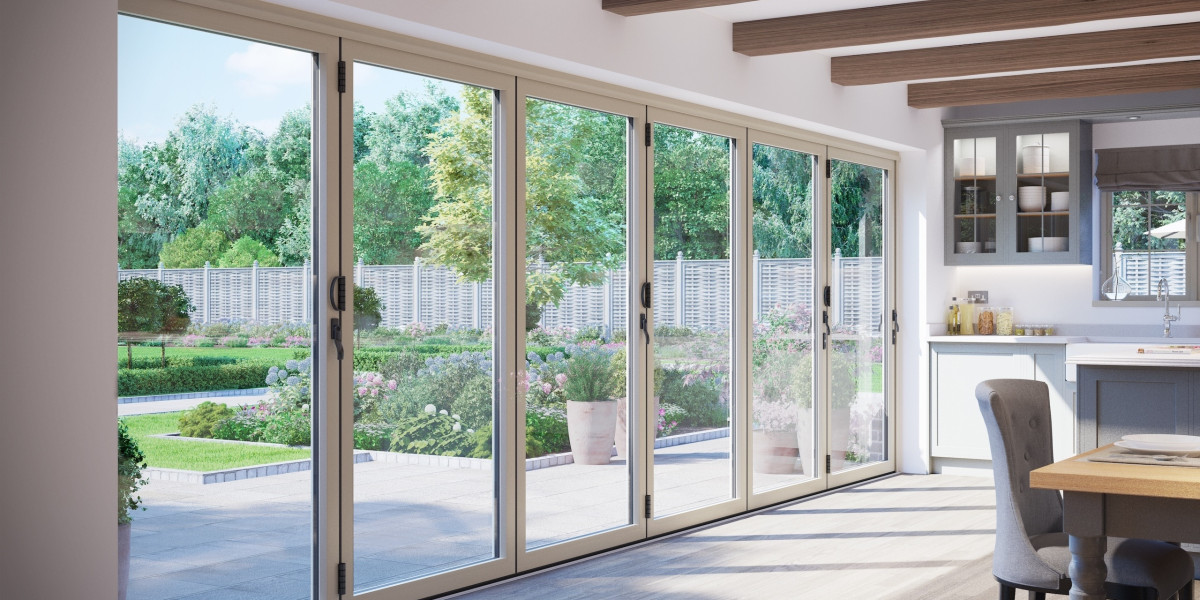
Bifold Door Repair: A Comprehensive Guide to Fixing Common Issues
Bifold doors, likewise referred to as folding doors, are a popular option for property owners wanting to take full advantage of space and develop seamless transitions between spaces or indoor and outside living locations. Their sophisticated, space-saving style permits large openings without the swing space needed by traditional hinged doors. From closets and kitchens to patio areas and space dividers, bifold door repair consultation doors provide flexibility and visual appeal. However, like any mechanical part in a home, bifold doors can experience wear and tear over time, causing numerous functional issues. Luckily, lots of common bifold door issues are workable with some standard DIY abilities and the right assistance.
This short article acts as a comprehensive guide to understanding and dealing with typical bifold door repairs. We will check out common problems, equip you with the required tools and knowledge, and walk you through detailed repair procedures. By comprehending the mechanics of bifold doors and finding out standard repair strategies, homeowners can extend the lifespan of their doors and avoid expensive expert service calls.
Understanding Common Bifold Door Problems
Before diving into repairs, it's crucial to identify the root cause of the issue. Bifold doors, while fairly basic in style, depend on numerous elements working in consistency. When one part breakdowns, it can affect the whole system. Here are a few of the most regular concerns property owners encounter with bifold doors:
- Hanging or Sticking Doors: This is perhaps the most typical problem. Doors might get stuck while opening or closing, require extreme force to move, or scrape versus the frame or flooring. This can be brought on by misaligned hinges, warped doors, or concerns with the track and roller system.
- Misaligned Doors: Even when closed, bifold door pivot repair doors should sit flush and lined up. Misalignment can manifest as gaps in between door panels, irregular spacing from the frame, or a failure to latch effectively. This can arise from loose hinges, distorted doors, or shifted tracks.
- Damaged or Broken Hardware: The rollers, hinges, pivots, and tracks are the workhorses of a bifold door system. With time and with regular use, these parts can wear, break, or become harmed. Damaged rollers can avoid smooth moving, while harmed hinges can trigger sticking and misalignment. Damaged tracks can block roller motion and result in jerky operation.
- Loose Screws and Fittings: Vibrations from regular usage can loosen screws and fittings that hold the hinges, tracks, and other hardware in location. Loose components can cause instability, misalignment, and noisy operation.
- Deformed Doors: Exposure to wetness and temperature changes can cause wood bifold doors to warp. Deformed doors can be hard to close properly, may rub versus the frame, and can develop spaces.
Essential Tools and Materials for Bifold Door Repair
Having the right tools and products on hand will make the repair procedure substantially smoother and more effective. Here's a list of common products you may require:
- Screwdrivers: A set of Phillips head and flathead screwdrivers of various sizes is essential for tightening and loosening up screws.
- Drill/Driver: For more persistent screws or for setting up new hardware, a drill/driver can be indispensable. Guarantee you have a variety of drill bits and screwdriver bits.
- Hammer: A hammer can be practical for gently tapping parts into location or for eliminating persistent pins.
- Pliers: Pliers work for gripping small parts, bending metal components, and removing pins.
- Level: A level is essential for guaranteeing doors are correctly lined up vertically and horizontally.
- Tape Measure: For precise measurements when replacing parts or adjusting door positions.
- Wood Shims: Shims are thin pieces of wood utilized for leveling and aligning doors within the frame.
- Lube (Silicone Spray or Dry Lube): Lubricant can significantly improve the smooth operation of rollers and hinges.
- Replacement Rollers, Hinges, and Tracks: Depending on the issue, you may require to buy replacement parts. It's typically valuable to identify the producer and design of your bifold doors to ensure you get compatible replacements.
- Wood Filler or Epoxy (for wood doors): For repairing small damage to wood doors, such as cracked corners or screw holes.
- Shatterproof Glass and Gloves: Always prioritize security when undertaking DIY jobs.
Step-by-Step Bifold Door Repair Guide
Now, let's explore the useful steps for repairing common bifold door issues:
1. Addressing Hanging or Sticking Doors:
- Inspection: Begin by carefully observing where the door is sticking or hanging. Is it rubbing versus the top, bottom, or side of the frame?
- Lubrication: Often, a simple lubrication of the rollers and track can fix sticking concerns. Apply silicone spray or dry lube to all moving parts, including rollers, hinges, and the top and bottom tracks. Open and close the door several times to distribute the lubricant.
- Hinge Adjustment: If lubrication doesn't fix the problem, check the hinges. Loose hinges can trigger doors to sag. Tighten up any loose hinge screws. If the screws are removed, you might need to use longer screws or wood filler in the screw holes before re-screwing.
- Track Adjustment: In some cases, the track itself might be a little misaligned. Inspect if the track is firmly secured to the frame. If it's loose, tighten up the screws. Minor track misalignment can in some cases be corrected by gently tapping the track into place with a hammer and block of wood.
- Door Warping: If the door is deformed, minor warping might be dealt with by thoroughly correcting it utilizing clamps and weights. Nevertheless, seriously distorted doors may need to be replaced.
2. Repairing Misaligned Doors:
- Hinge Adjustment (Lateral Alignment): Misalignment can frequently be remedied by adjusting the hinges. Loosen up the hinge screws slightly and gently move the door panel left or right to accomplish better alignment. Retighten the screws when aligned.
- Shims (Vertical Alignment): If the door is irregular vertically, you can use shims. Unlock and location shims behind the depend upon the lower panel to raise it or behind the hinges on the upper panel to lower it. Try out shim placement and thickness until the doors are aligned, then tighten up the hinge screws securely.
- Leveling the Frame: In rare cases, the door frame itself might be out of level. Utilize a level to check the frame. If it's not level, you may require to adjust the frame itself, which can be a more complex job and may require professional assistance.
3. Replacing Damaged Hardware (Rollers, Hinges, Tracks):
- Roller Replacement:
- Open the bifold door and find the harmed roller.
- Depending on the design, you might require to remove a maintaining clip or screw to launch the old roller.
- Carefully eliminate the old roller.
- Insert the brand-new roller, guaranteeing it is effectively seated and protected.
- Check the door operation.
- Hinge Replacement:
- Open the door and recognize the damaged hinge.
- Remove the screws holding the hinge to both door panels and the frame.
- Get rid of the old hinge.
- Position the new hinge in the exact same place.
- Protect the new hinge with screws.
- Check the door operation.
- Track Replacement: Replacing a track is a more involved procedure and is typically just needed if the track is significantly harmed or bent.
- Get rid of the bifold doors from the track.
- Loosen the old track from the frame.
- Step and cut the brand-new track to the appropriate length, if necessary.
- Position the new track and protect it to the frame with screws.
- Reinstall the bifold doors.
- Evaluate the door operation.
4. Tightening Loose Screws and Fittings:
- Regular Inspection: Periodically examine all screws and fittings on your bifold doors.
- Tightening: Use a screwdriver to tighten any loose screws.
- Stripped Screw Holes: If screws are consistently loosening up or removed, you can use wood filler (for wood doors) or epoxy to repair the screw holes. Fill the hole, let it dry, pre-drill a pilot hole, and then re-install the screw. Alternatively, usage slightly longer or larger screws to get a better grip.
Regular Maintenance for Bifold Doors
Preventative maintenance is key to extending the life of your bifold doors and lessening the need for repairs. Here are some vital maintenance pointers:
- Regular Cleaning: Keep the tracks and rollers tidy from dust, particles, and family pet hair. Vacuum or clean down tracks routinely.
- Lubrication: Lubricate rollers and hinges at least twice a year or whenever you see the doors beginning to stick or squeak.
- Inspect Hardware Periodically: Check for loose screws, used rollers, or damaged hinges during your routine home upkeep checks.
- Mild Operation: Avoid slamming or requiring bifold doors. Operate them smoothly and carefully to avoid unnecessary stress on the hardware.
When to Call a Professional
While numerous bifold door problems can be taken on DIY, there are scenarios where it's finest to call an expert handyman or door expert:
- Significant Door Warping: Severely warped doors might be beyond DIY repair and need expert replacement.
- Complex Track Issues: If the track is substantially bent, damaged, or if you suspect structural issues with the frame, professional know-how is recommended.
- Absence of DIY Experience: If you are unpleasant with DIY repairs or do not have the needed tools, looking for professional aid is constantly a safe and sensible option.
- Time Constraints: If you are brief on time or choose to have the repair done quickly and effectively, a specialist can deal with the job.
Conclusion
Bifold doors are an important addition to any home, using area performance and aesthetic appeal. Understanding their mechanics and common issues empowers homeowners to carry out fundamental repairs and upkeep, guaranteeing their durability and smooth operation. By following the steps detailed in this guide, and with a little perseverance and the right tools, you can successfully resolve most bifold door concerns and keep your doors operating flawlessly for years to come. Keep in mind, routine upkeep and timely attention to minor concerns can avoid bigger problems and save you money and time in the long run.
Frequently Asked Questions (FAQs) about Bifold Door Repair
Q: Why are my bifold doors sticking?A: Sticking bifold doors are typically triggered by absence of lubrication, misaligned hinges, or particles in the tracks and rollers.
Q: How often should I lube bifold door rollers?A: It's advised to oil bifold door installers door rollers a minimum of two times a year or whenever you see the doors becoming less smooth to run.
Q: Can I replace bifold closet doors bifold door rollers myself?A: Yes, replacing bifold door rollers is a reasonably uncomplicated DIY job. Ensure you buy compatible replacement rollers for your door type.
Q: My bifold doors are misaligned even when closed. How can I fix this?A: Misalignment can typically be fixed by adjusting the hinges. Try loosening hinge screws and gently shifting door panels for better positioning, or utilize shims behind hinges to adjust vertical alignment.
Q: What type of lubricant is best for bifold door rollers?A: Silicone spray or dry lubricant are exceptional options for bifold door rehabilitate door rollers as they are less likely to bring in dust and debris compared to oil-based lubricants.
Q: When should I consider changing my bifold doors instead of repairing them?A: Consider changing bifold doors if they are considerably deformed, thoroughly damaged, or if the expense of repairs surpasses the cost of new doors, particularly if they are old and worn out.







